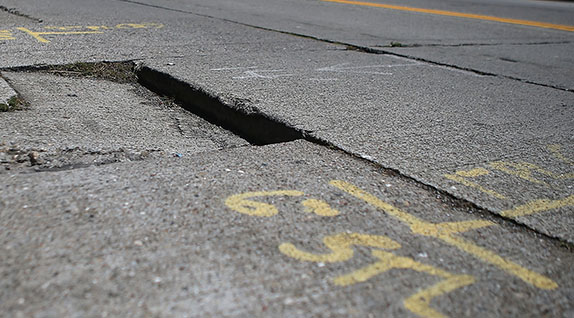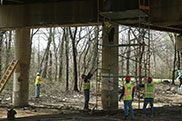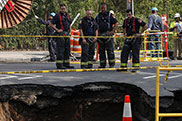 Justin Sullivan/Getty Images
Justin Sullivan/Getty Images
Article
Millions in the United States believe their lifestyles filled with modern conveniences will continue forever. But the underpinnings of the country—including its electrical grids and transportation systems—tell a different story.
Learn the why behind the headlines.
Subscribe to the Real Truth for FREE news and analysis.
Subscribe Now“There are a lot of people in the United States right now who think the country is falling apart, and at least in one respect they’re correct. Our roads and bridges are crumbling, our airports are out of date and the vast majority of our seaports are in danger of becoming obsolete. All the result of decades of neglect. None of this is really in dispute. Business leaders, labor unions, governors, mayors, congressmen and presidents have complained about a lack of funding for years, but aside from a onetime cash infusion from the stimulus program, nothing much has changed. There is still no consensus on how to solve the problem or where to get the massive amounts of money needed to fix it…”
This was the dire opening to a 60 Minutes segment on America’s infrastructure. The public’s focus on this ongoing issue may have waned, but ignoring the problem is not making it go away. We are a mere tragedy away from facing the frightening reality of the nation’s condition.
The sweeping scale of the problem is not always foremost because infrastructure—power grids, water and sewer systems, etc.—is largely hidden from the naked eye. The average person gives little thought to it but for one exception: when it does not work.
In this age of modern technology, medical advances, and an International Space Station, it seems incredible that the vital infrastructure of the United States, the world’s most powerful nation, is collapsing. The major challenge? Tightened purse strings.
The Economist reported: “America saw two great booms in infrastructure spending in the past century, the first during the Great Depression…and the second in the 1950s and 60s, when most of the interstate highway system was [constructed]. Since then, public infrastructure spending as a share of GDP has declined to about half the European level. America is one of the most car-dependent nations on earth, yet it spends about as large a share of GDP on roads as Sweden…The federal government scrimps on airports and sewage pipes so it can pay for pensions and health care.”
Most do not realize that the U.S. is hurtling toward a time when vital utilities will regularly drop out, roadways will become impassable due to disrepair, and blackouts will cripple metropolitan areas.
Millions believe the comfort and luxury afforded to nearly every American will go on forever. But, without drastic intervention, the nation inevitably faces ruinous collapse.
America Scores Low
“We’ve been talking about this for many many years,” Patrick Natale, executive director of the American Society of Civil Engineers (ASCE), told CNN. “We really haven’t had the leadership or will to take action on it. The bottom line is that a failing infrastructure cannot support a thriving economy.”
After reviewing several areas of America’s infrastructure, ASCE issued its 2013 report card (the most recent data available), which gave the nation a bleak cumulative ranking of “D+.”
The results for the individual categories were equally telling: Aviation, D; Bridges, C+; Dams, D; Drinking Water, D; Energy, D+; Hazardous Waste, D; Inland Waterways, D-; Levees, D-; Public Parks and Recreation, C-; Rail, C+; Roads, D; Schools, D; Solid Waste, B-; Wastewater, D; Transit, D.
In 2009, the ASCE grade was D.
Despite a slight improvement in the cumulative ranking, conditions remain relatively the same nearly seven years later.
Imagine if your child brought home the same poor grades year after year. You would certainly take action! However, American infrastructure is able to skate by with barely passing grades because the situation is seemingly not yet dire.
 Mark Wilson/Getty Images
Mark Wilson/Getty Images
The ASCE estimates that the U.S. needs $3.6 trillion by 2020 to address all of these concerns. This is staggering—especially when considering that the nation is plagued by ever-increasing debt. Daily, the government spends an average of $9.5 billion—with total U.S. debt over $19 trillion. Because of massive expenditures on the military, healthcare and education—and necessarily so—there is little room in the government’s budget to spend trillions of dollars on infrastructure nationwide.
Shaky Foundation—Shaky Future
How important to the health of our nation is our infrastructure? Just as the proper functioning of the circulatory, nervous and skeletal systems is vital to your body’s health and well-being, the nation’s infrastructure is vital to the success of its citizens. Utilities and services must be maintained to allow Americans to live the way they do. Without them, nearly everything in the U.S. comes to an immediate halt.
The 2013 ASCE report card detailed the level of disrepair and decay and showed how infrastructure plays into almost every part of day-to-day life.
Roads: “Forty-two percent of America’s major urban highways remain congested, costing the economy an estimated $101 billion in wasted time and fuel annually. While the conditions have improved in the near term, and Federal, state, and local capital investments increased to $91 billion annually, that level of investment is insufficient and still projected to result in a decline in conditions and performance in the long term. Currently, the Federal Highway Administration estimates that $170 billion in capital investment would be needed on an annual basis to significantly improve conditions and performance.”
Bridges: “Over two hundred million trips are taken daily across deficient bridges in the nation’s 102 largest metropolitan regions. In total, one in nine of the nation’s bridges are rated as structurally deficient, while the average age of the nation’s 607,380 bridges is currently 42 years. The Federal Highway Administration (FHWA) estimates that to eliminate the nation’s bridge deficient backlog by 2028, we would need to invest $20.5 billion annually, while only $12.8 billion is being spent currently. The challenge for federal, state, and local governments is to increase bridge infrastructure investments by $8 billion annually to address the identified $76 billion in needs for deficient bridges across the United States.”
Drinking Water: “At the dawn of the 21st century, much of our drinking water infrastructure is nearing the end of its useful life. There are an estimated 240,000 water main breaks per year in the United States. Assuming every pipe would need to be replaced, the cost over the coming decades could reach more than $1 trillion, according to the American Water Works Association (AWWA). The quality of drinking water in the United States remains universally high, however. Even though pipes and mains are frequently more than 100 years old and in need of replacement, outbreaks of disease attributable to drinking water are rare.”
Public Transportation: “America’s public transit infrastructure plays a vital role in our economy, connecting millions of people with jobs, medical facilities, schools, shopping, and recreation, and it is critical to the one-third of Americans who do not drive cars. Unlike many U.S. infrastructure systems, the transit system is not comprehensive, as 45% of American households lack any access to transit, and millions more have inadequate service levels. Americans who do have access have increased their ridership 9.1% in the past decade, and that trend is expected to continue. Although investment in transit has also increased, deficient and deteriorating transit systems cost the U.S. economy $90 billion in 2010, as many transit agencies are struggling to maintain aging and obsolete fleets and facilities amid an economic downturn that has reduced their funding, forcing service cuts and fare increases.”
Other areas of America’s infrastructure require the following budget increases in order to be repaired:
- Wastewater: $298 billion
- Schools: $270 billion
- Levees: $100 billion
- Dams: $21 billion
The list goes on and on.
Widespread Blackouts
One of the most outdated and overburdened parts of America’s infrastructure, which its citizens perhaps most take for granted, is the electrical grid.
What would life be like without electricity? When did you last walk up 42 stories due to an inoperable elevator? How would you prepare meals without a stove or microwave? Failed alarm systems, downed traffic lights, dead telephone lines, and no Internet access are just a few of the additional problems you would face.
 Kena Betancur/AFP/Getty Images
Kena Betancur/AFP/Getty Images
The ASCE states the electrical grid is in urgent need of modernization.
“The electric grid in the United States consists of a system of interconnected power generation, transmission facilities, and distribution facilities, some of which date back to the 1880s. Today, we have an aging and complex patchwork system of power generating plants, power lines, and substations that must operate cohesively to power our homes and businesses. There are thousands of power generating plants and systems spread across the United States and almost 400,000 miles of electric transmission lines. With the addition of new gas-fired and renewable generation, the need to add new transmission lines has become even greater.
“Aging equipment has resulted in an increasing number of intermittent power disruptions, as well as vulnerability to cyber attacks. Significant power outages have risen from 76 in 2007 to 307 in 2011…Reliability issues are also emerging due to the complex process of rotating in new energy sources and ‘retiring’ older infrastructure.”
A report from International Business Times stated that the average number of power outages increases each year, and that blackouts cost American business $150 billion annually.
What happens when the power ceases to flow?
In the summer of 2003, the power went out for much of the northeastern United States, as well as parts of eastern Canada.
The New York Times reported during the event: “Office workers who were still at their desks watched their computer monitors blink off without warning on a hot and hazy afternoon. Soon hospitals and government buildings were switching on backup generators to keep essential equipment operating, and the police were evacuating people trapped in elevators.”
“Traffic jams grew to dozens of miles long, stranding buses and even emergency vehicles, as police officers and platoons of well-meaning citizens tried to control the streets with hand-lettered stop-and-go signs. Hundreds of subway and commuter trains were paralyzed, some in tunnels, including a Long Island Rail Road train that was trapped beneath the East River with no air-conditioning for almost two hours.”
The blackout affected as many “as 50 million customers in the United States and Canada, as well as a wide range of vital services and commerce,” ASCE reported. “Air and ground transportation systems shut down, trapping people far from home; drinking water systems and sewage processing plants stopped operating, manufacturing was disrupted and some emergency communications systems stopped functioning. The lost productivity and revenue have been estimated in the billions of dollars.”
Region-wide loss of power cripples the flow of everyday life. No electricity means no television, no place to charge your cellphone, no Internet access, no working gas pumps—virtually every part of the daily routine is affected.
The 2003 blackout was relatively short-lived. Consider if the outages were longer—what violence, looting and rioting would soon grip a city in darkness?
Disaster upon Disaster
The United States must summon $3.6 trillion over the next four years to begin fixing its deteriorating physical foundation. This is $3.6 trillion the nation does not have. For the once-towering economic leader, this is a tragic and crippling problem.
Crumbling infrastructure means one thing for the individual—without drastic and widespread intervention, each individual in America is destined for a severe change of life. One with spotty electricity, less Internet access, impassible roads riddled with potholes, more deadly gas leaks and explosions, higher food prices, and water that has to be boiled to ensure it is safe to drink.
To the average American citizen, this is unthinkable. Yet just sitting down to watch a daily 30-minute news program reveals a different view. On top of failing bridges and roadways, outdated electrical grids and levee systems, and pipes bursting every two minutes are news report after news report of countless tragedies—crises of all kinds—disaster upon disaster.
Unemployment, immigration woes, pension and social security concerns, homegrown terrorists, oil spills, earthquakes and citywide flooding are just a small sample of what America faces. Put together, these crises will cost the nation additional trillions.
After reviewing the facts, one can feel defeated and think: How did we get ourselves to this point? Why has it come to this?
Unknown to most, this coming period for America was foretold long ago—and with it comes the reason for the United States’ decline.
The Old Testament of the Bible details the coming state of the nation: “Mischief shall come upon mischief, and rumor shall be upon rumor” (Ezek. 7:26). The antiquated language hides the true meaning of the phrase. The Strong’s Exhaustive Concordance of the Bible entry for “mischief” includes the terms ruin and disaster. The word “rumor” includes the terms news and report.
Certainly, there is tragic news report after tragic news report today! Before one set of crises is addressed, another consumes the nation.
Yet God’s Word reveals that—while events will improve for a time—they will ultimately become much worse. The book of Ezekiel states, “An end is come, the end is come: it [awakes against you]; behold, it is come” (7:6).
There is a period ahead when disasters and ruin will pile upon one another.
During this time, the consumer-driven economy will cease to exist: “The time is come, the day draws near: let not the buyer rejoice, nor the seller mourn: for wrath is upon all the multitude thereof” (vs. 12).
Accumulated luxury items will be useless: “They shall cast their silver in the streets, and their gold shall be removed: their silver and their gold shall not be able to deliver them in the day of the wrath of the Lord” (vs. 19).
Ezekiel also states that there comes a point when God intends to punish America. When that time comes, His judgment will be swift and exacting.
“Now I will shortly pour out My fury upon you, and accomplish My anger upon you: and I will judge you according to your ways, and will recompense you for all your abominations” (vs. 8).
But why would He do this?
Before punishment, there will be a warning about national sins and what will come if there is no change. God always warns before chastisement, leaving no excuse for those who continue in ruinous behavior.
That warning message, detailed in the pages of the Bible, is plainly explained on The World to Come with David C. Pack. This broadcast, coupled with unique analysis found in The Real Truth magazine, will continue to paint the picture of what is to come—and how it will affect you.
More on Related Topics:
- Colombia’s Capital Starts Rationing Water After Reservoirs Hit Historically Low Levels
- U.S. Border Security: What Could President Biden, Congress and Texas Do?
- Haiti’s Surge in Gang Violence Has Led More Than 53,000 to Flee the Capital in Less Than Three Weeks
- Baltimore Bridge Collapse Highlights Need to Protect Critical Foundations
- Drug Overdoses Reach Another Record with Almost 108,000 Americans in 2022, CDC Says


